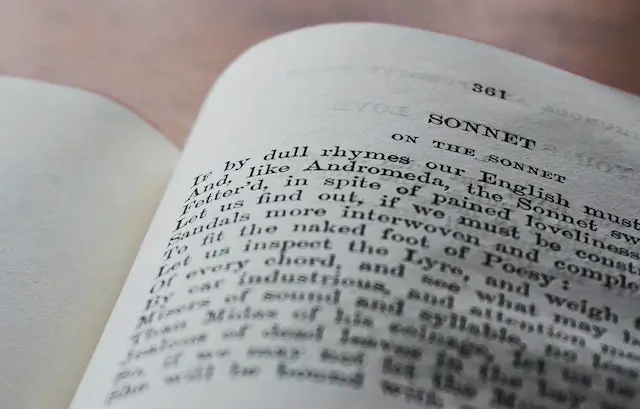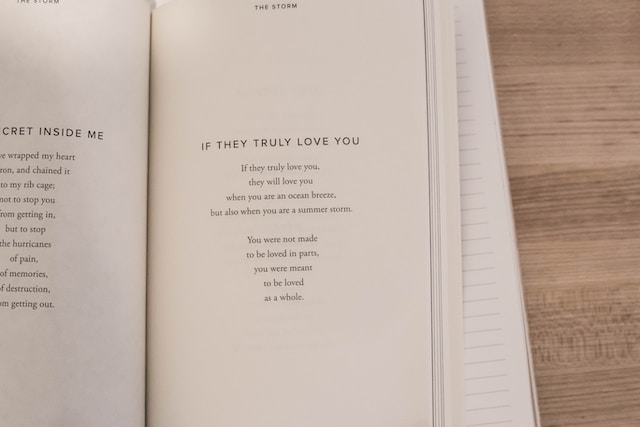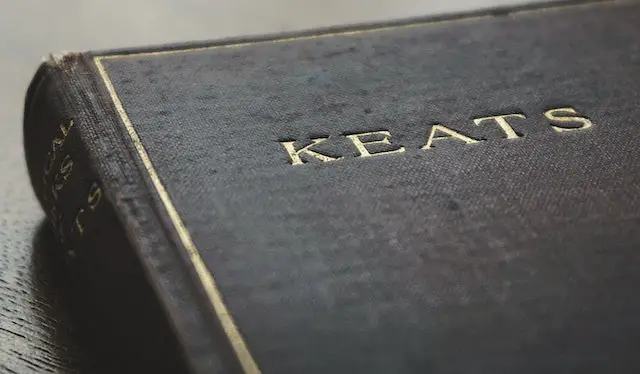A sonnet is a type of poem that has a specific structure of 14 lines with a particular rhyme scheme and meter. A poem is a more general term that refers to any type of literary work that uses language to express emotions, ideas, or experiences in a creative and imaginative way.
What is a sonnet?
(Photo by Suzy Hazelwood)

A sonnet is a specific type of poem that originated in Italy during the Renaissance. Sonnets typically consist of fourteen lines of iambic pentameter, which means that each line has ten syllables with a pattern of an unstressed syllable followed by a stressed syllable. The rhyme scheme of a sonnet is usually abab cdcd efef gg, although there are many variations.
Sonnets often focus on themes of love, loss, or beauty, and they often have a turn, or volta, at the end of the octave (the first eight lines). This turn signals a change in the poem’s perspective or theme. Shakespeare’s famous “Sonnet 18” is an excellent example of a traditional sonnet:
Shall I compare thee to a summer’s day?
Thou art more lovely and more temperate:
Rough winds do shake the darling buds of May,
And summer’s lease hath all too short a date:
Sometime too hot the eye of heaven shines,
And often is his gold complexion dimmed;
And every fair from fair sometime declines,
By chance or nature’s changing course untrimmed;
But thy eternal summer shall not fade
Nor lose possession of that fair thou owest;
Nor shall Death brag thou wander’st in his shade,
When in eternal lines to time thou grow
What is a poem?
(Photo by Thought Catalog on Unsplash )

A poem is a literary work that uses language to express emotions, ideas, or experiences in a creative and imaginative way. Poems often use figurative language, rhythm, and sound to convey meaning, and they come in a variety of styles, including sonnets, haikus, free verse, and ballads. Poems can be written about a wide range of subjects, from nature and love to social and political issues.
Sonnet Vs. Poem – Key differences
The key differences between sonnets and poems are as follows:
Structure: Sonnets have a specific structure that consists of 14 lines, usually written in iambic pentameter, and with a specific rhyme scheme. Poems, on the other hand, can have various structures, and there is no set rule for how they should be written.
Rhyme: Sonnets have a specific rhyme scheme that varies depending on the type of sonnet being written. Poems, on the other hand, may or may not have a rhyme scheme, depending on the poet’s preference.
Theme: Sonnets often have a specific theme, such as love or beauty, that is explored throughout the poem. Poems can be written on any subject and explore a wide range of themes.
Tone: Sonnets often have a formal and structured tone, while poems can have a more casual or conversational tone.
Purpose: Sonnets were originally created to express love, but they can be used to explore other themes as well. Poems can be written for various purposes, such as to entertain, inform, or express emotions.
Sonnets are a specific type of poem that follows a strict structure and rhyme scheme, while poems can be written in a variety of styles and explore a wide range of themes.
Sonnet examples
The word “sonnet” comes from the Italian word for “little song.” Sonnets typically explore deep emotions or big ideas, and they often have a turn, or shift, in the final six lines.
“How Do I Love Thee?” by Elizabeth Barrett Browning:
“How do I love thee? Let me count the ways.
I love thee to the depth and breadth and height
My soul can reach, when feeling out of sight
For the ends of being and ideal grace.”
“On His Blindness” by John Milton:
“When I consider how my light is spent
Ere half my days in this dark world and wide,
And that one talent which is death to hide
Lodged with me useless, though my soul more bent”
“Death, be not proud” by John Donne:
“Death, be not proud, though some have called thee
Mighty and dreadful, for thou art not so;
For those whom thou think’st thou dost overthrow
Die not, poor Death, nor yet canst thou kill me.”
Poem examples
There are many different types of poems, and each one has its own set of rules and guidelines. However, sonnets and poems are two of the most popular types of poetry. So, what is the difference between a sonnet and a poem?
Here are a few examples of poems:
“The Road Not Taken” by Robert Frost:
“Two roads diverged in a wood, and I—
I took the one less traveled by,
And that has made all the difference.”
“Still I Rise” by Maya Angelou:
“You may write me down in history
With your bitter, twisted lies,
You may trod me in the very dirt
But still, like dust, I’ll rise.”
“Ode to a Nightingale” by John Keats:
“My heart aches, and a drowsy numbness pains
My sense, as though of hemlock I had drunk,
Or emptied some dull opiate to the drains
One minute past, and Lethe-wards had sunk:”
These poems vary in their style, subject matter, and structure. They may or may not have a specific rhyme scheme or structure, and they explore a wide range of themes, from nature to social issues to personal experiences.
What makes a poem a sonnet?
A sonnet is a specific form of poetry that consists of 14 lines and follows a specific rhyme scheme and structure. The traditional sonnet has the following characteristics:
- Consists of 14 lines.
- Written in iambic pentameter.
- Follows a specific rhyme scheme, typically ABAB CDCD EFEF GG.
- Often explores themes of love, beauty, nature, mortality, or other emotional experiences.
- Has a specific turn or shift in tone or subject matter, called a “volta,” usually occurring between the eighth and ninth lines.
So, what makes a poem a sonnet is its adherence to these specific rules and characteristics.
Is Romeo and Juliet a poem or sonnet?
Romeo and Juliet is a play written by William Shakespeare. It is one of his most famous works, and is considered to be a classic of English literature. The play tells the story of two young lovers, Romeo Montague and Juliet Capulet, who are from rival families in the city of Verona. The lovers are forced to hide their relationship from their families, and eventually they both die in a tragic turn of events.
While Romeo and Juliet is not technically a sonnet, it does share some similarities with this form of poetry. A sonnet is typically 14 lines long, with a specific rhyme scheme. It also usually has a turn, or volta, around the 8th or 9th line. In Romeo and Juliet, there are several passages that could be considered sonnets, such as Juliet’s famous balcony scene speech:
“But soft! What light through yonder window breaks?
It is the east, and Juliet is the sun!”
However, the majority of the play is written in blank verse, which is unrhymed iambic pentameter. This makes it more similar to a traditional poem than a sonnet.
Featured Image By – Photo by Suzy Hazelwood








